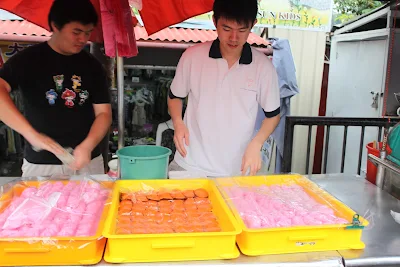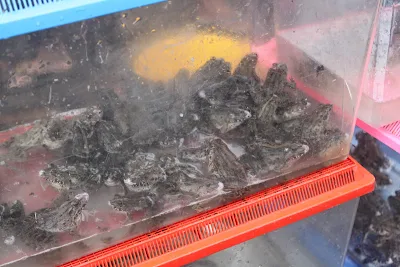There are so many "Sydneys", not just a monolithic one. Just as many residents have long felt, there are multiple townships that collectively are labelled with one regional name reference, but with characteristics that can be as different and far apart as chalk and cheese, individualistic and communal, outdoor and inward looking.
Taking these thoughts to another dimension, there can be at least two different Australian economies, if not more. Often such various communities and economies interact in trade, pass by each other on the street or sit beside each other on buses and trains, but their internal drivers, passions and preoccupations can vary and differ. Yet at the same time, they are all influenced by commonalities at grassroots or suggested by national nuances. Politics, religion, landscape topography and the nature of work may divide them, but choice of food, lingo, sport and relationships may bring them back again. Just like having Cadbury hot chocolate after a serving of Malaysian chicken red curry, albeit cooked with potatoes and meat, on a recent Qantas Boeing flight. When overseas, Australians from different backgrounds still gather at iconic homes away from home - like working expats having their morning coffee meetings at the Dilbumah cafe inside the Chevron complex facing Raffles Place in Singapore.
Driving through Sydney districts, I sample through some of the variety on most weekends, provided I am willing to travel and persist through a long day and night - but the resulting rewards are worth the experience. I savour the details in the way people drive ( for example between the Illawarra area and Asian demographic suburbs), in the language used on shop displays along main streets and in the number of retail outlets still opened for business after 5pm and on weekends. I can see the various ways in which some communities gather, celebrate, reflect and relax. Viewing, playing or ignoring sports perhaps contribute to a critical parameter that differentiates Australians at key stages of life from school to the pub. Attitudes to mateship and family spring up as another significant parameter in different parts of Sydney. Specific usage of public versus private transport, preferences for hot versus cold dishes in everyday snacks or quick lunch time meals and having a choice of pets also all come to mind.
When faced with the same set of joys and pain, such differences are quickly cast aside. Whether caught up in the annual firework displays at the harbour, or recognising the sacrifices made by troops based overseas, Sydney siders - and other Australians for that matter - can naturally dive into what unites us rather than separate us. Whether we hail from the mountains, plains, inner city or coastal shires, we endure pricey parking fees, persistent traffic jams, shopping centre crowds, inflation rates higher than what we are told and the need to protect our skins better. We also love the breeze over our hair, the sight of the deep blue bays and beach sides, long weekends away, queueing up, outdoor activities and just having a chockie on a beaut day.
Kindly Yours - A collection of writings, thoughts and images. This blog does contain third party weblinks. No AI content is used.
Thursday, 24 February 2011
Sunday, 13 February 2011
Penang Island - Scenes from Black Water Village
Air Itam (Indonesian or Malay literally for 'Black Water") is nestled below the central spine hills of Penang island, at the north-west corner of the Malaysian Peninsular and lying between Phuket and Pangkor Isles.
A densely populated suburb not far from Penang's capital city of Georgetown, Air Itam is also the site of the Kek Lok Si, one of the largest Buddhist temple and monastery complexes in Asia. Just below this complex is one of the most lively market conurbations in Malaysia - and when you visit in the early hours after dawn, you are treated to a lively spectacle swirling with people, produce and practicality.
Penangites love their easily accessible snacks, with traditional Straits Chinese cakes (or kueh) above, made fresh each day and very affordable in costs, leading the popular choice. Left to right, steamed and airy light huat kueh in pink and the ang ku (or literally, the red tortoise) in the centre tray. Each bright red coloured ang ku sits on a small piece of banana leaf and is both savoury and sweet in taste, being made of cooked yellow bean paste and wrapped inside dough.
Like in any Italian pasta, Shanghai mien or Osaka ramen outlet, the making of fresh noodles, in this case egg noodles in Air Itam, constitutes a labour of passion and attention. White flour permeates, cutting of the dough is precise and fingers are flexible to add to the flurry of activity.
Patterns and designs from a paper lantern (above) and below, the Malaysian cousin to the Queensland paw paw. Both were on open display as you stroll past the myriad of sights, sounds and items on sale.
Below, a scene comparable to dunking doughnuts. The crisp and freshly made dough-based deep fried stick (yau chiow kuai in Cantonese) is given a soak of thick black coffee. This is a particularly popular practice at breakfast time at various street corners and coffee shops in places like Thailand, Vietnam and Hong Kong.
An ubiquitous snack (above) is the light weight apong, or pancake, swerved flat or in rolls. They have to be eaten fresh and preferably with fingers.
Typical of any south-east Asian market, those in Air Itam have both essential ingredients like dried shrimps (above) and startling offers like live frogs on display (below).
The entrance to another market in Air Itam (above) can lead to eye openers and organic produce (below).
Welcoming The Lunar Year of the Rabbit
Abalone strips adorn vegetables and garnishing on plate in foreground above.
Steamed sago bubbles are bathed in a mixture of coconut milk and sweet Malacca palm sugar (above).
Above, roast duck cutlets ala Hong Kong from the Asian roast meat outlet in Sydney's suburbs.
Below, the Straits Chinese favourite of lobak, deep fried spring rolls wrapped with both vegetables and meat.
The yee sang, or literally fish alive, is made only at Lunar New Year time.
Basically a sashimi salad, laced with fine strips of various carefully selected ingredients like pomelo grapefruit bits, crunchy stuff and salmon pieces, the mixture creates different sensations for the palate. Families and mates gather around this dish, each person with a pair of chopsticks on hand, to collectively stir through this concoction in a symbolic act of generating dynamic wealth and health.
All dishes above were photographed at the home of Susan and Boo Ann Yap in Carlingford, New South Wales on 2 February 2011.
Georgetown's Hotel Penaga
The penchant for boutique residences, holiday lifestyles and heritage restorations all meet at a junction along Hutton Lane in the old quarter of Penang Island's Georgetown. A whole block of early twentieth century double storey terrace houses has been renovated and rebuilt into a unique experience for visitors seeking an alternative to hotel chains that apparently offer more of the same around the world. Low rise in structure, utilising lots of dark coloured wood panelling and suggesting an ambiance of times gone past, the Hotel Penaga infuses and blends both its external and interior decor with memories of British, Straits Chinese and Malay influences - much like this tropical isle itself is.
There are the obligatory bar and dining areas - with names like Tanglong (meaning 'Lantern") and stark white tablecloths. We had martinis, tia marias and cofffee. Also on the bar list were Pims and Bombay Sapphires.
Outside, a south Indian coffee shop was chock-a-block with youths watching intently a football match on the ESPN channel. Light rain moistened the tarred roads outside, matching the rather quiet elegance of the hotel functional rooms inside.
Antique Straits Chinese window frames form the center piece as one checks into the lobby. There is generous use of stained coloured glass, brass knobs, ornamental lamps and carvings inspired by the likes of the Malayan peninsular and Bali. Looking from outside, some of the character of the original British Malaya architecture is retained, although now topped up discretely by hints of southern Chinese roof styles. There may be plumbing issues to over come though - the taps were not exactly user friendly when we visited.
Hotel Penaga has attempted to evoke a time of when tea and pepper merchants crossed paths with colonial government servants, South-east Asian royalty and Australian naval officers. Today it tries to lure bond and currency traders, political brokers, internet professionals and new China hands to its corridors.
Friday, 4 February 2011
Subscribe to:
Comments (Atom)
To Declutter
There are things I should have started long ago to clear up. I am good at putting in one place unfinished tasks. Written lists of quest...
-
The Japanese and some south east Asians believe even non animate things have a spiritual presence. I generally refer to it as a lifeforce. ...
-
Parramatta in New South Wales was settled by the British within a few months of landing at Sydney Cove. Today, in an adjoining suburb, H...
-
Traditional siew mai or steamed pork and prawn dumplings. Golden egg custard, sans caramel, is the key to a delicious tarn tart. Char siew...




































